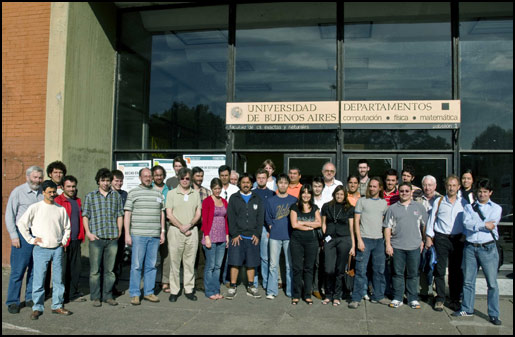
ATLAS e-News
23 February 2011
Latin American Software & Computing Workshop/Tutorial
31 March 2008

Participants of the Latin America Software and Computing Workshop/Tutorial pictured outside the physics building of the Universidad de Buenos Aires, Buenos Aires, Argentina
The computing resources needed to extract physics results form ATLAS are so large that they necessarily are distributed worldwide. It is important to the success of ATLAS that these remote resources and remote physicists can be just as productive as those at the host lab, CERN. In preparation for this remote participation with an eye on the upcoming ATLAS data taking later this year, a workshop on ATLAS software and computing was held at the Universidad de Buenos Aires (UBA) 10 – 14 March, 2008.
Organized by Ricardo Piegaia (UBA), Maria Teresa Dova (Universidad Nacional de La Plata (UNLP)) and Dario Barberis (CERN and Genoa University/INFN), the workshop focused on a number of key aspects of preparing for ATLAS data. In particular, preparing the Latin American ATLAS members for physics analysis, with an emphasis on getting new collaborators engaged in ATLAS. There were a number of ATLAS specific lectures on grid computing, the Athena framework, Data Management and Physics Analysis Tools Lectures were interspersed with hands-on tutorials where students and other participants tried out the software tools and ran analysis jobs on simulated data.
Participation was from 4 Latin American countries and 7 institutes:
- Universidad de Buenos Aires, Argentina
- Universidad Nacional de La Plata, Argentina
- Univ. Federal do Rio de Janeiro, Brazil
- Universidad Austral, Valdivia, Chile
- Universidad Católica, Santiago, Chile
- Univ. Técnica Federico Santa María, Valparaíso, Chile
- Universidad Antonio Nariño, Bogotá, Colombia
as well as a number of European countries and the United States. In total, we had participants from 13 different nationalities and 4 continents.
Following a format that has worked very well in ATLAS, experienced ATLAS members helped the newer members get through the tutorials and perform tasks like a real trigger aware analysis. Specific tutorials covered the details of basic grid usage, finding and accessing ATLAS data (simulated and cosmic ray), running trigger aware analysis interactively and the basics of distributed analysis on the grid. A final tutorial covered various workflows involved in analysis and the tools available to facilitate analysis such as EventView, the use of TAGs for skimming data, using GANGA and PanDA. This introduced many tools to the participants such as Athena Root Access, ROOT/PyROOT and PROOF.
More details of the workshop are available on the CERN agenda system.
The workshop benefited from the direct support of:
- The EU-funded HELEN (High-Energy Latin-american European Network) project that supports HEP activities in Latin America and for this workshop funded the travel from Europe of five participants, including three young tutors;
- The U.S. National Science Foundation (NSF) through its Office of International Science and Engineering (OISE) together with the Directorate for Math and Physical Sciences (MPS) supported the travel costs for two postdocs and two graduate students to participate and lead tutorials at the Workshop.
Local support was provided by:
